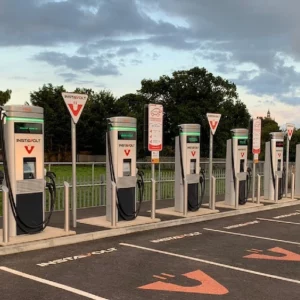Blogs
22 November 2022
Reading Time: 4 mins
Blogs
22 November 2022
Reading Time: 4 mins

Eseye
IoT Hardware and Connectivity Specialists
LinkedInRising consumer interest in sustainable living, combined with legislation designed to move the UK towards all new vehicles being 100% ‘zero emission’ from 2035, is increasing the demand for electric vehicles. The number of EVs on our roads is growing month by month.
The public charging infrastructure needs to keep pace with demand, which is why the government is investing so heavily in its development.
Equally as important as the ubiquity and availability of charging points is their efficiency and reliability. If drivers are unable to find a charging station when they need one, or they experience problems with the speed of the charging process, for example, this will dent consumer confidence in EVs and damage commercial viability for operators.
Charging stations offer the potential for functionality that goes far beyond simply providing somewhere to plug in an electric vehicle. They are devices that can be connected via IoT technology to the vehicle, the EV charging operator, their management system, the driver’s smartphone and even the utility company, enabling the various data points involved in the charging process to interact and share information. This gives operators the opportunity to optimise the charging process and enhance the driver experience, through features that provide added convenience, control and efficiency.
For the operator, these features might include the ability to dynamically balance the load between charging vehicles according to demand, and diagnose issues with charging stations remotely. Drivers, meanwhile, will be able to take advantage of the capability to book and pay for a charging slot in advance through a smartphone app, for example.
Our latest IoT industry research revealed that IoT adoption in the EV sector is growing quickly, with the number of devices in the field rising. Many operators are already experiencing the fruits of their initiatives, with 31% reporting that adopting IoT has enabled them to enter new markets, and 30% that it has led to operational efficiencies, while 29% have been able to increase revenue.
The future growth potential for intelligent connectivity in the EV arena is also clear. When asked whether IoT is a priority in the coming two to three years, 80% of respondents in the EV charging and smart grid sector said it was – the joint highest percentage among all sectors – while 97% plan to increase their budget in this area in the next two years.

IoT technology clearly has a leading role to play in accelerating the EV revolution. However, any unreliability or friction in the charging system will send progress in the opposite direction, putting consumers off purchasing EVs, while eroding operators’ profitability and reputation and putting the government’s ambitious environmental targets at risk. This makes reliable connectivity absolutely pivotal to the future of the sector.
Connectivity between public EV charging stations largely works via the Open Charge Point Protocol (OCPP), while most home chargers use Wi-Fi, Bluetooth, and cellular technology. There are challenges and potential points of failure associated with each of these options – including the possibility of service outages, slow network speeds, and security vulnerabilities.
Cellular connectivity offers distinct advantages over alternative technologies, including flexibility and robust security, but can bring pain points of its own.
In our survey, respondents from the EV charging and smart grid sector highlighted a number of concerns related to connectivity – including the complexity of managing multiple carrier or provider contracts (27%), unsurprising given the dispersed nature of EV charging infrastructure, as well as the need to manage existing legacy SIMs all in one place (20%).
When we asked what would make future IoT initiatives more successful, 28% of respondents mentioned the desire to have a single platform for all IoT connectivity regardless of supplier. Many multinational enterprises with global IoT operations struggle to operate with a multiplatform strategy due to the complexity of juggling numerous providers and their respective platforms, contracts and billing.

Eseye’s advanced Infinity IoT Platform™ was the reason InstaVolt – provider of the UK’s largest owner-operated rapid EV charging network – chose to work with us. Each of its charge points is designed to operate in the field for up to 30 years. Our AnyNet+ SIMs are built in, and futureproof InstaVolt’s solution by allowing the charge points to switch mobile networks seamlessly to take advantage of the best available coverage at any moment. This provides near 100% connectivity uptime across InstaVolt’s nationwide rapid and ultra-rapid charging stations, and a centralised platform through which it can manage every individual connection.
Connectivity is the backbone of the EV charging network. As the industry matures, reliable IoT connectivity solutions that can evolve over time will be the key to providing the availability, consistency of service, charging speeds, hassle-free experience and value-add services that customers expect. This will build their trust and confidence and, in turn, promote wider EV adoption.

Eseye
IoT Hardware and Connectivity Specialists
LinkedInEseye brings decades of end-to-end expertise to integrate and optimise IoT connectivity delivering near 100% uptime. From idea to implementation and beyond, we deliver lasting value from IoT. Nobody does IoT better.
Predictable performance is the key to IoT success. Let our experts test your device for free. Receive a free trial IoT SIM trial kit and speed up your IoT deployment with expert insights and seamless connectivity.